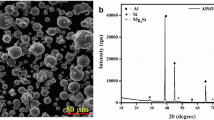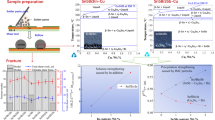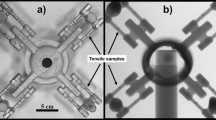Abstract
The purpose of this work is to investigate the effect of various percentages of Al addition to bulk microstructure, intermetallic compound (IMC) formation, wetting and mechanical properties of Sn–0.3Ag–0.5Cu (SAC0305) solder. SAC0305, SAC-0.5Al, SAC-1Al, SAC-1.5Al and SAC-2Al solders were prepared via casting process. The solders were reflowed onto Cu substrate at 260 °C for 10 s. The composition of each solders were determined using X-Ray Fluorescent. Differential Scanning Calorimetry was used to evaluate the thermal properties while wetting balance test and spreading test were conducted to analyze the wettability. The microstructures of the bulk solder as well as the interfacial IMC layer were observed using Scanning Electron Microscope equipped with Energy Dispersive X-ray. Meanwhile, ball shear test was carried out to assess the reliability of the solder joints. Addition of Al had increased the melting and crystallization temperature of the solders but decreased the degree of undercooling. The wettability of solders decreased with the increasing amount of Al, but still in the acceptable range. Addition of Al had encouraged the formation of Ag–Al and Cu–Al IMC, suppressed the formation of Ag3Sn and Cu6Sn5 IMC and refined β-Sn dendrites. Further addition of Al above 1 wt% resulted in the formation of primary Al particles. The amount of Ag–Al and Cu–Al IMC and primary Al particles increased with increasing amount of Al. The Al-added solders have thinner IMC layer at the solder joint compared to SAC0305 for reflowed samples. The shear strength of Al added solder were higher than SAC0305 at high and low speed shear.










Similar content being viewed by others
References
M. Abtew, G. Selvaduray, Lead-free solders in microelectronics. Mater. Sci. Eng. 27, 95–141 (2000)
W.R. Osório, L.C. Peixoto, L.R. Garcia, N. Mangelinck-Noël, A. Garcia, Microstructure and mechanical properties of Sn–Bi, Sn–Ag and Sn–Zn lead-free solder alloys. J. Alloys Compd. 572, 97–106 (2013). doi:10.1016/j.jallcom.2013.03.234
X. Hu, K. Li, Z. Min, Microstructure evolution and mechanical properties of Sn0.7Cu0.7Bi lead-free solders produced by directional solidification. J. Alloys Compd. 566, 239–245 (2013). doi:10.1016/j.jallcom.2013.03.034
M. Wang, J. Wang, H. Feng, W. Ke, Effect of Ag3Sn intermetallic compounds on corrosion of Sn-3.0Ag-0.5Cu solder under high-temperature and high-humidity condition. Corros. Sci. 63, 20–28 (2012). doi:10.1016/j.corsci.2012.05.006
D. Li, C. Liu, P.P. Conway, Microstructure and shear strength evolution of Sn–Ag–Cu solder bumps during aging at different temperatures. J. Electron. Mater. 35, 388–398 (2006). doi:10.1007/BF02690524
D.A.-A. Shnawah, S.B.M. Said, M.F.M. Sabri, I.A. Badruddin, T.G. Hoe, F.X. Che et al., Microstructure and tensile properties of Sn-1Ag-0.5Cu solder alloy bearing Al for electronics applications. J. Electron. Mater. 41, 2073–2082 (2012). doi:10.1007/s11664-012-2135-1
T. Graedel, Material substitution: a resource supply perspective. Resour. Conserv. Recycl. 34, 107–115 (2002). doi:10.1016/S0921-3449(01)00097-0
L.M. Higgins III, The move to lead-free manufacturing (n.d.). http://connection.ebscohost.com/c/articles/8654414/move-lead-free-manufacturing. Accessed 23 Jan 2015
I.E. Anderson, Development of Sn–Ag–Cu and Sn–Ag–Cu–X alloys for Pb-free electronic solder applications, in Lead-free Electronic Solders (2006), pp. 55–76. doi:10.1007/978-0-387-48433-4_4
K.S. Tan, K.Y. Cheong, Advances of Ag, Cu, and Ag–Cu alloy nanoparticles synthesized via chemical reduction route. J. Nanoparticle Res. 15, 1537 (2013). doi:10.1007/s11051-013-1537-1
S. Terashima, Y. Kariya, T. Hosoi, M. Tanaka, Effect of silver content on thermal fatigue life of Sn–xAg–0.5Cu flip-chip interconnects, J. Electron. Mater. 1527–1533 (2003). http://www.scopus.com/inward/record.url?eid=2-s2.0-0942299489&partnerID=tZOtx3y1
L.R. Garcia, W.R. Osório, L.C. Peixoto, A. Garcia, Mechanical properties of Sn–Zn lead-free solder alloys based on the microstructure array and Ag3Sn morphology. Mater. Charact. 562, 194–204 (2009). doi:10.1016/j.matchar.2009.11.012
A.K. Gain, T. Fouzder, Y.C. Chan, A. Sharif, W.K.C. Yung, Investigation of small Sn–3.5Ag–0.5Cu additions on the microstructure and properties of Sn–8Zn–3Bi solder on Au/Ni/Cu pads. J. Alloys Compd. 489, 678–684 (2010). doi:10.1016/j.jallcom.2009.09.150
L.R. Garcia, W.R. Osório, A. Garcia, The effect of cooling rate on the dendritic spacing and morphology of Ag3Sn intermetallic particles of a SnAg solder alloy. Mater. Des. 32, 3008–3012 (2011). doi:10.1016/j.matdes.2010.12.046
J. Gong, C. Liu, P.P. Conway, V.V. Silberschmidt, Modelling of Ag3Sn coarsening and its effect on creep of Sn–Ag eutectics. Mater. Sci. Eng. A 427, 60–68 (2006). doi:10.1016/j.msea.2006.04.034
M.F.M. Sabri, D.A. Shnawah, I.A. Badruddin, S.B.M. Said, F.X. Che, T. Ariga, Microstructural stability of Sn–1Ag–0.5Cu–xAl (x = 1, 1.5, and 2 wt%) solder alloys and the effects of high-temperature aging on their mechanical properties. Mater. Charact. 78, 129–143 (2013). doi:10.1016/j.matchar.2013.01.015
D.A.-A. Shnawah, S.B.M. Said, M.F.M. Sabri, I.A. Badruddin, F.X. Che, Microstructure, mechanical, and thermal properties of the Sn–1Ag–0.5Cu solder alloy bearing Fe for electronics applications. Mater. Sci. Eng. A 551, 160–168 (2012). doi:10.1016/j.msea.2012.04.115
D. Kim, D. Suh, T. Millard, H. Kim, C. Kumar, M. Zhu et al., Evaluation of high compliant low Ag solder alloys on OSP as a drop solution for the 2nd level Pb-free interconnection, in 2007 Proceedings 57th Electron Components Technology Conferences, IEEE (2007), pp. 1614–1619. doi:10.1109/ECTC.2007.374010
D. Suh, D.W. Kim, P. Liu, H. Kim, J.A. Weninger, C.M. Kumar et al., Effects of Ag content on fracture resistance of Sn–Ag–Cu lead-free solders under high-strain rate conditions. Mater. Sci. Eng. A 460–461, 595–603 (2007). doi:10.1016/j.msea.2007.01.145
K. Kittidacha, W. Kanjanavikat, A. Vattananiyom, Effect of SAC alloy composition on drop and temp cycle reliability of BGA with NiAu pad finish, in Proceedings 10th IEEE-ECTC Conferences (2003) pp. 1074–1079
S.-H. Huh, K.-S. Kim, K. Suganuma, Effects of Ag addition on the microstructural and mechanical properties of Sn–Cu eutectic solder. Mater. Trans. 42, 739–744 (2001). doi:10.2320/matertrans.42.739
H.X. Xie, N. Chawla, Y.-L. Shen, Mechanisms of deformation in high-ductility Ce-containing Sn–Ag–Cu solder alloys. Microelectron. Reliab. 51, 1142–1147 (2011). doi:10.1016/j.microrel.2011.02.005
K. Kanlayasiri, M. Mongkolwongrojn, T. Ariga, Influence of indium addition on characteristics of Sn–0.3Ag–0.7Cu solder alloy. J. Alloys Compd. 485, 225–230 (2009). doi:10.1016/j.jallcom.2009.06.020
A.E. Hammad, Evolution of microstructure, thermal and creep properties of Ni-doped Sn–0.5Ag–0.7Cu low-Ag solder alloys for electronic applications. Mater. des. 52, 663–670 (2013)
A.A. El-daly, A.M. El-taher, S. Gouda, Novel Bi-containing Sn–1.5Ag–0.7Cu lead-free solder alloy with further enhanced thermal property and strength for mobile products. J. Mater. 65, 796–805 (2015). doi:10.1016/j.matdes.2014.10.006
A.-M. Yu, M.-S. Kim, C.-W. Lee, J.-H. Lee, Wetting and interfacial reaction characteristics of Sn-1.2Ag-0.5Cu-xIn quaternary solder alloys. Met. Mater. Int. 17, 521–526 (2011). doi:10.1007/s12540-011-0634-x
L. Gao, S. Xue, L. Zhang, Z. Sheng, F. Ji, W. Dai et al., Effect of alloying elements on properties and microstructures of SnAgCu solders. Microelectron. Eng. 87, 2025–2034 (2010). doi:10.1016/j.mee.2010.04.007
Y.-S. Park, Y.-M. Kwon, H.-Y. Son, J.-T. Moon, B.-W. Jeong, K.-I. Kang et al., Effect of Sb addition in Sn–Ag–Cu solder balls on the drop test reliability of BGA packages with electroless nickel immersion gold (ENIG) surface finish, in 2007 International Conferences Electronic Material Package, IEEE (2007). pp. 1–5. doi:10.1109/EMAP.2007.4510317
A.-M. Yu, J.-K. Kim, J.-H. Lee, M.-S. Kim, Pd-doped Sn–Ag–Cu–In solder material for high drop/shock reliability. Mater. Res. Bull. 45, 359–361 (2010). doi:10.1016/j.materresbull.2009.12.030
M.N. Islam, Y.C. Chan, Wetting and interfacial reactions of Sn-Zn based lead-free solder alloys as replacement of Sn-Pb solder, in Proceeding 2005 International conferences Asian green electronic design for manufacturability and reliability 2005AGEC. (2005), pp. 178–184. doi:10.1109/AGEC.2005.1452341
K.J. Puttlitz, K.A. Stalter, Handbook of lead-free solder technology for microelectronic assemblies (CRC Press, 2004). http://books.google.com/books?hl=en&lr=&id=7FX5LkxfRpwC&pgis=1. Accessed 25 Jan 2015
Atsdr, Toxicological profile for aluminum. Cutan. Ocul. Toxicol. 18, 357 (2008). doi:10.3109/15569529909037564
M. Rettenmayr, P. Lambracht, B. Kempf, M. Graff, High melting Pb-Free solder alloys for die-attach applications. Adv. Eng. Mater. 7, 965–969 (2005). doi:10.1002/adem.200500124
K. Suganuma, S. Kim, K. Kim, High-temperature lead-free solders: properties and possibilities. JOM 61(1), 64–71 (2009)
R.E. Smallman, R.J. Bishop, Modern Physical Metallurgy and Materials Engineering, 6th edn. (1999), pp. 42–83
E.B. Ferreira, M.L. Lima, E.D. Zanotto, DSC method for determining the liquidus temperature of glass-forming systems. J. Am. Ceram. Soc. 93, 3757–3763 (2010). doi:10.1111/j.1551-2916.2010.03976.x
A.A. El-Daly, W.M. Desoky, T.A. Elmosalami, M.G. El-Shaarawy, A.M. Abdraboh, Microstructural modifications and properties of SiC nanoparticles-reinforced Sn–3.0Ag–0.5Cu solder alloy. Mater. Des. 65, 1196–1204 (2015). doi:10.1016/j.matdes.2014.08.058
A.A. El-Daly, G.S. Al-Ganainy, A. Fawzy, M.J. Younis, Structural characterization and creep resistance of nano-silicon carbide reinforced Sn–1.0Ag–0.5Cu lead-free solder alloy. Mater. Des. 55, 837–845 (2014). doi:10.1016/j.matdes.2013.10.043
S.K. Kang, W.K. Choi, D. Shih, D.W. Henderson, T. Gosselin, A. Sarkhel et al., Ag3Sn plate formation in the solidification of near-ternary eutectic Sn–Ag–Cu measurement. JOM 55(6), 61–65 (2003)
Lead Free Solder Reflow for Semiconductor Power Devices, article AN 0601 (2006), pp. 1–3. www.ixys.com. Accessed 16 Mar 2015
A.A. El-Daly, A.E. Hammad, G.S. Al-Ganainy, M. Ragab, Influence of Zn addition on the microstructure, melt properties and creep behavior of low Ag-content Sn–Ag–Cu lead-free solders. Mater. Sci. Eng. A 608, 130–138 (2014). doi:10.1016/j.msea.2014.04.070
A.E. Hammad, Investigation of microstructure and mechanical properties of novel Sn–0.5Ag–0.7Cu solders containing small amount of Ni. Mater. Des. 50, 108–116 (2013)
J.K. Walleser, I.E. Anderson, Microstructure control of the Sn–Ag–Cu–X solder alloy system through nucleation catalysis of Sn (2008). http://gradworks.umi.com/14/74/1474773.html. Accessed 30 Jan 2015
A.N. Campbell, R. Kartzmark, The systems aluminum-tin and aluminum-lead-tin. Can. J. Chem. 34(10), 1428–1439 (1956)
A. Kantarcıoğlu, Y.E. Kalay, Effects of Al and Fe additions on microstructure and mechanical properties of SnAgCu eutectic lead-free solders. Mater. Sci. Eng. A 593, 79–84 (2014). doi:10.1016/j.msea.2013.11.025
W. Ryan, Properties of ceramic raw materials. Elsevier (1978). doi:10.1016/B978-0-08-022113-7.50007-1
R.T. Hrubiec, M.B. Smith, Silver nitrate/alumina: a chromatographic reaction medium for conversion of 5-halogenopent-2-enes into 1-cyclopropylethyl nitrate. J. Chem. Soc. Perkin Trans. 1, 107 (1984). doi:10.1039/p19840000107
V. Kripesh, C.T. Tai, G. Vishwanadam, Development of a lead free chip scale package for wireless applications, in 2001 Proceedings 51st Electronic Components Technology Conferences (Cat. No. 01CH37220), IEEE, (2001), pp. 665–670. doi:10.1109/ECTC.2001.927802
K. Chew, V. Kho, Comparative wetting ability of lead-free alloys. Time 3, 3–8 (2003)
G. Kumar, K.N. Prabhu, N. Prabhu, S.W. Dean, Wetting behavior of solders. J. ASTM Int. 7, 103055 (2010). doi:10.1520/JAI103055
C.J.J. Hang, C.Q.Q. Wang, M. Mayer, Y.H.H. Tian, Y. Zhou, H.H.H. Wang, Growth behavior of Cu/Al intermetallic compounds and cracks in copper ball bonds during isothermal aging. Microelectron. Reliab. 48, 416–424 (2008). doi:10.1016/j.microrel.2007.06.008
Y. Tang, G.Y. Li, Y.C. Pan, Influence of TiO2 nanoparticles on IMC growth in Sn–3.0Ag–0.5Cu–xTiO2 solder joints in reflow process. J. Alloys Compd. 554, 195–203 (2013). doi:10.1016/j.jallcom.2012.12.019
D.-G. Kim, S.-B. Jung, Interfacial reactions and growth kinetics for intermetallic compound layer between In–48Sn solder and bare Cu substrate. J. Alloys Compd. 386, 151–156 (2005). doi:10.1016/j.jallcom.2004.05.055
X. Ma, F. Wang, Y. Qian, F. Yoshida, Development of Cu–Sn intermetallic compound at Pb-free solder/Cu joint interface. Mater. Lett. 57, 3361–3365 (2003). doi:10.1016/S0167-577X(03)00075-2
I. Aisha, A. Ourdjini, A. Astuty, O. Azlina, Effect of silver content on intermetallic formation on copper and immersion silver surface finishes (n.d.). https://scholar.google.com/scholar?cluster=17551346128779884658&hl=en&oi=scholarr#0. Accessed 31 Jan 2015
B. Chao, S.-H. Chae, X. Zhang, K.-H. Lu, J. Im, P.S. Ho, Investigation of diffusion and electromigration parameters for Cu–Sn intermetallic compounds in Pb-free solders using simulated annealing. Acta Mater. 55, 2805–2814 (2007). doi:10.1016/j.actamat.2006.12.019
G. Li, X. Shi, N. Metals, Effects of bismuth on growth of intermetallic compounds in Sn–Ag–Cu Pb-free solder joints. Trans. Nonferrous Met. Soc. China 16, s739–s743 (2006). doi:10.1016/S1003-6326(06)60292-6
K.N. Tu, R.D. Thompson, Kinetics of interfacial reaction in bimetallic Cu/Sn thin films. Acta Metall. 30, 947–952 (1982). doi:10.1016/0001-6160(82)90201-2
H. Nishikawa, N. Iwata, Formation and growth of intermetallic compound layers at the interface during laser soldering using Sn–Ag Cu solder on a Cu Pad. J. Mater. Process. Technol. 215, 6–11 (2014). doi:10.1016/j.jmatprotec.2014.08.007
B.F. Dyson, Interstitial diffusion of copper in tin. J. Appl. Phys. 38, 3408 (1967). doi:10.1063/1.1710127
K. Hoshino, Y. Iijima, K. Ichi Hirano, Interdiffusion and Kirkendall effect in Cu–Sn alloys. Trans. Jpn. Inst. Metals 21, 674–682 (1980)
J.F. Li, P.A. Agyakwa, C.M. Johnson, Effect of trace Al on growth rates of intermetallic compound layers between Sn-based solders and Cu substrate. J. Alloys Compd. 545, 70–79 (2012). doi:10.1016/j.jallcom.2012.08.023
O.O.M. Abdelhadi, L. Ladani, IMC growth of Sn-3.5 Ag/Cu system: Combined chemical reaction and diffusion mechanisms. J. Alloys Compd. 537, 87–99 (2012). doi:10.1016/j.jallcom.2012.04.068
B.L. Chen, G.Y. Li, Influence of Sb on IMC growth in Sn–Ag–Cu–Sb Pb-free solder joints in reflow process. Thin Solid Films 462–463, 395–401 (2004). doi:10.1016/j.tsf.2004.05.063
D.K.B. Donald R Askeland, Pradeep P Fulay, Essentials of materials science and engineering: SI edition (2010), p. 604. http://library.alibris.com/Essentials-of-Materials-Science-and-Engineering-SI-Edition-Donald-R-Askeland/book/11310680. Accessed 31 Jan 2015
S. Li, C. Basaran, Effective diffusivity of lead free solder alloys. Comput. Mater. Sci. 47, 71–78 (2009). doi:10.1016/j.commatsci.2009.06.015
D.Q. Yu, C.M.L. Wu, C.M.T. Law, L. Wang, J.K.L. Lai, Intermetallic compounds growth between Sn–3.5Ag lead-free solder and Cu substrate by dipping method. J. Alloys Compd. 392, 192–199 (2005). doi:10.1016/j.jallcom.2004.09.023
S.-S. Ha, J.-K. Jang, S.-O. Ha, J.-W. Kim, J.-W. Yoon, B.-W. Kim et al., Mechanical property evaluation of Sn-3.0A-0.5Cu BGA solder joints using high-speed ball shear test. J. Electron. Mater. 38, 2489–2495 (2009). doi:10.1007/s11664-009-0916-y
J.-W.W. Kim, Y.-C.C. Lee, S.-S.S. Ha, S.-B.B. Jung, Failure behaviors of BGA solder joints under various loading conditions of high-speed shear test. J. Mater. Sci.: Mater. Electron. 20, 17–24 (2008). doi:10.1007/s10854-008-9588-2
M.O.O. Alam, H. Lu, C. Bailey, Y.C.C. Chan, Fracture mechanics analysis of solder joint intermetallic compounds in shear test. Comput. Mater. Sci. 45, 576–583 (2009). doi:10.1016/j.commatsci.2008.12.001
X. Huang, Investigation and analysis on the solder ball shear strength of plastic ball grid array, chip scale, and flip chip packages with eutectic Pb-Sn and Pb-free solders, (2003). http://repository.ust.hk/ir/Record/1783.1-596. Accessed 30 Jan 2015
W.D. Callister, D.G. Rethwisch, Fundamentals of Materials Science and Engineering: An Integrated Approach, 4th edn. (2012), pp. 197–233
K. Zeng, R. Stierman, T.-C. Chiu, D. Edwards, K. Ano, K.N. Tu, Kirkendall void formation in eutectic SnPb solder joints on bare Cu and its effect on joint reliability. J. Appl. Phys. 97, 024508 (2005). doi:10.1063/1.1839637
S.-M.M. Joo, H.-K.K. Kim, Shear deformation behavior of a Sn–3Ag–0.5Cu single solder ball at intermediate strain rates. Mater. Sci. Eng. A 528, 2711–2717 (2011). doi:10.1016/j.msea.2010.12.003
Acknowledgments
This work is supported by Fundamental Research Grant Scheme (FRGS) Grant No. 203/PBAHAN/6071243. The authors gratefully acknowledge the support provided by Ministry of Education Malaysia (MOE) and Universiti Sains Malaysia (USM) for ASTS fellowship scheme.
Author information
Authors and Affiliations
Corresponding author
Rights and permissions
About this article
Cite this article
Maslinda, K., Anasyida, A.S. & Nurulakmal, M.S. Effect of Al addition to bulk microstructure, IMC formation, wetting and mechanical properties of low-Ag SAC solder. J Mater Sci: Mater Electron 27, 489–502 (2016). https://doi.org/10.1007/s10854-015-3780-y
Received:
Accepted:
Published:
Issue Date:
DOI: https://doi.org/10.1007/s10854-015-3780-y




